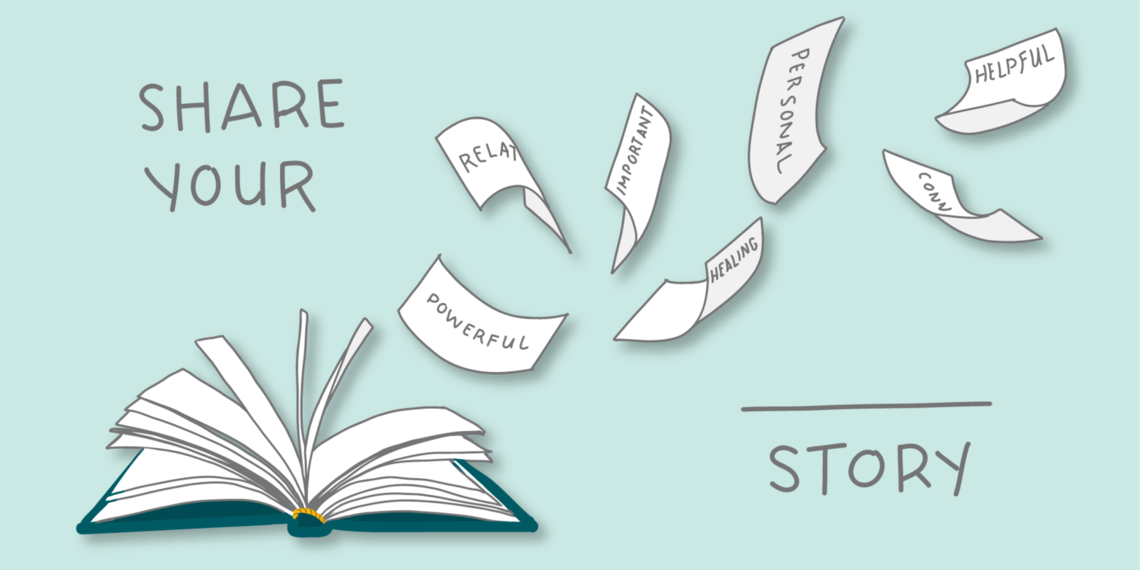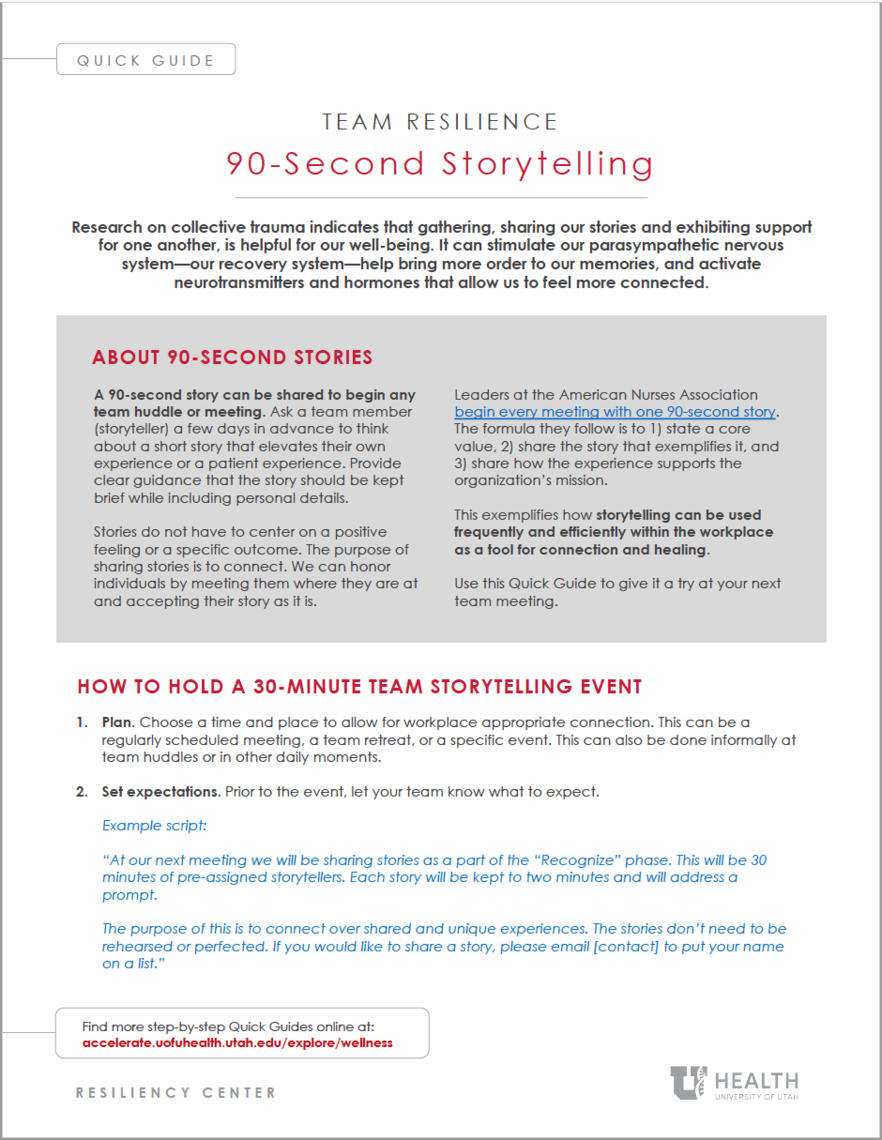esearch on collective trauma indicates that storytelling is helpful for our well-being. It can stimulate our parasympathetic nervous system—our recovery system—helping to bring more order to our memories, and activating neurotransmitters and hormones that allow us to feel more connected.
Communities and cultures have relied on storytelling for collective healing for hundreds of years. To paraphrase Bryan Doerries on the performance of Greek tragedies: Greeks developed this public form of storytelling to serve a purpose. The purpose was to communalize trauma and create conditions to reflect together. The word “amphitheater” in Greek means “the place where we go to see in both directions.” “Amphi,” means I see you, you see me; both directions. “Theatron,” is the seeing place.
We go to the amphitheater to see each other, to see ourselves, to see that we are not the only people to have felt isolated, scared, angry, or even optimistic—and not just because it’s being enacted onstage but because people around us in this semicircular structure are all validating and acknowledging the truth of what we’re experiencing.
90-second storytelling for meetings
Leaders at the American Nurses Association begin every meeting with one 90-second story. The formula they follow is to 1) state a core value, 2) share the story that exemplifies it, and 3) share how the experience supports the organization’s mission.
This structure is a tool to frequently and efficiently use storytelling within the workplace as a means for connection and healing.
A 90-second story can be shared to begin any team huddle or meeting. Ask a storyteller a few days in advance to think about a short story that elevates their own experience or a patient experience. Provide clear guidance that the story should be kept brief while including personal details.
Stories do not have to center on a positive feeling or a specific outcome. The purpose of sharing stories is to connect. We can honor individuals by meeting them where they are at and accepting their story as it is.
How to hold a 30-minute team storytelling session
1. Plan. Choose a time and place to allow for workplace-appropriate connection. This can be a regularly scheduled meeting, a team retreat, or a specific event. This can also be done informally at team huddles or in other daily moments.
2. Set expectations. Prior to the event, let your team know what to expect. In order to build safety and normalize sharing, you may want to begin by sharing a story. Or, ask influential formal or informal leaders to share their stories.
Example script:
“At our next meeting we will be sharing stories. This will be 30 minutes of pre-assigned storytellers. Each story will be kept to two minutes and will address a prompt.
The purpose of this is to connect over shared and unique experiences. The stories don’t need to be rehearsed or perfected. If you would like to share a story, please email [contact] to put your name on a list.”
3. Prepare. After 6-10 storytellers have signed up, send out the prompt that you’ve chosen for the event (see below). Remind storytellers to reflect professional consideration and workplace appropriateness. Ask them to prepare to share for no more than two minutes.
Sample prompts:
-
How are you, really?
-
What ways are you being cared for (by self or others)?
-
What’s been challenging or what’s been meaningful?
-
What's it like being human in health care?
-
Share a patient experience
4. Facilitate. Assign a facilitator who can introduce the event, call on the storytellers, and keep time. The facilitator should read the following section to clarify expectations and share resources at the beginning of the event.
Script to create a safe space for sharing:
“What this is and what this isn’t…
-
This is a place for authentic, genuine, honest and heart-felt stories.
-
This is a place to hear a wide range of experiences, which may be different from your own.
-
This is a place for connection and community and a place to show support for one another.
-
This is not a place to share critical feedback to leaders. This can be done through other feedback systems.
-
This is not group therapy. This is a place to share personal stories in a professional context.
-
This is not intended to cause significant discomfort. If you are in distress and the stories you hear make this worse, then we ask that you take care of yourself, potentially using resources like HMHI, the Resiliency Center and EAP.”
Facilitator Tip: "Keep it moving." It’s tempting to fill the time in between storytellers with comments or reflections—especially when emotion surfaces. Instead, encourage comments to be shared in the chat (if on zoom) or to the individuals directly at another time. A simple “Thank you” is enough to acknowledge the storyteller.
5. Wrap-up and conclude. After the last storyteller, thank those who were willing to share their story. While many teams appreciate time for discussion and reflection after storytelling, this is optional. Sometimes it’s best to let the experience speak for itself.
See it in action
University of Utah Health recently hosted the Moving Forward Town Hall, an organization-wide storytelling session focused on a single question: How are you doing, really?

U of U Health employees can learn by watching Dr. Megan Call facilitate leaders and colleages from across the organization in storytelling for collective healing here.
Originally published May 2021
Cite this content: Jean Whitlock and Megan Call, “90-Second Storytelling for Connection and Healing”, Accelerate University of Utah Health curriculum, . Available at: http://accelerate.uofuhealth.utah.edu/explore/90-second-storytelling-for-connection-and-healing
Megan Jean Whitlock
Megan Call
Mindfulness educators Trinh Mai, Jean Whitlock, and Rob Davies guide us through a quick and simple exercise for reducing burnout and increasing well-being by remembering positive experiences and reflection.
For the past six years, mindfulness, professional well-being, equity and inclusion expert Trinh Mai has served as a contributor and core member of Accelerate’s editorial team. Now, as she charts a new path, we reflect with profound gratitude on everything she has taught us.
University of Utah Health social worker and director of mindfulness programming Trinh Mai partners with chaplain Saundra Shanti to explore a new way to manage the exhaustion we feel: permission to give 20% less.

